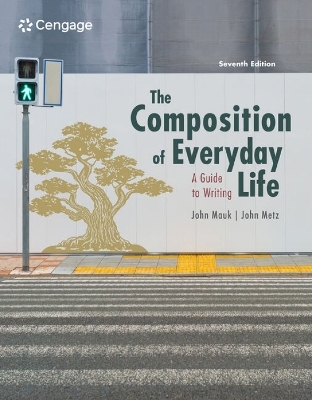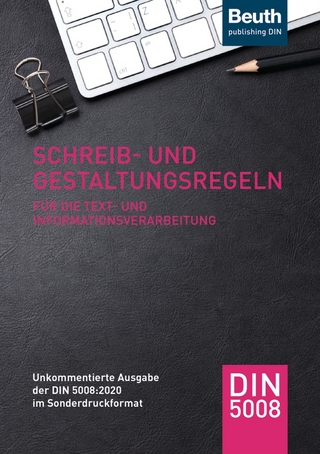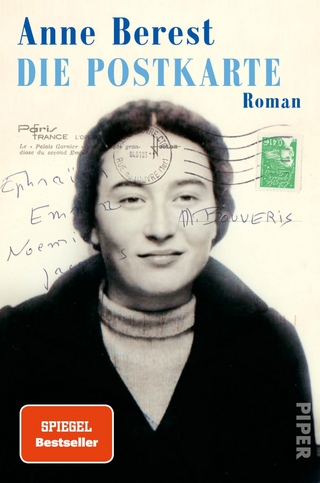
The Composition of Everyday Life
Wadsworth Publishing Co Inc (Verlag)
978-0-357-94583-4 (ISBN)
John Mauk, Ph.D., has a doctorate in rhetoric and writing from Bowling Green State University and a master's degree in language and literature from the University of Toledo. Over a 24-year career, he taught composition at Owens Community College, Northwestern Michigan College and Miami University. He was twice named professor of the year. He now writes in various genres, edits manuscripts for professional writers and teaches in continuing education programs. He also hosts Prose from the Underground, a video series featuring interviews and practical advice for working writers. John Metz began teaching college writing as a graduate student at the University of Toledo in 1983. He then taught at University of Toledo, Umpqua Community College and Kent State University over the next forty years. He focused on helping students learn to invent ideas, make appropriate rhetorical decisions and redefine what writing is or can be. His students sometimes said, “I thought this was supposed to be a writing course.”
Contents
Using CEL as a Thematic Reader
Note to Instructors
Acknowledgments
Chapter 1 Inventing Ideas
Introduction
Asking Questions
Re-Inventing Education
Reading for Rhetoric
Part I: Invention
Sample Essays
Writing Topics
Invention
Point of Contact
Analysis 1
Public Resonance
Thesis
Rhetorical Tools
Revision and Peer Review
Reflection
Part II: Research
Part III: Organization and Delivery
A Final Note on Artificial Intelligence and Practicing Writing
Inventing Ideas Assignment
Chapter 2 Remembering Who You Were
Introduction
Readings
“Selling Manure“ Bonnie Jo Campbell
“How I Lost the Junior Miss Pageant“ Cindy Bosley
“The Thrill of Victory . . . The Agony of Parents“ Jennifer Schwind-Pawlak
(Student Essay)
Invention
Point of Contact
Analysis ? Thinking Further
Public Resonance
Thesis ? Evolution of a Thesis ? Common Thesis Problem: Avoiding Clichés
? Revising Your Thesis
Rhetorical Tools ? Narration ? Allusions ? Dialogue
Revision ? Peer Review ? Peer Review Truisms
Reflection
Beyond the Essay: Invention Video
Chapter 3 Explaining Relationships
Introduction
Readings
“What the Honey Meant“ Cindy Bosley
“Dog-Tied“ David Hawes
“Mugged“ Jim Crockett
“To Fish and Be Fished: A Tinder-fied Game of Love“ Kellie Coppola
(Student Essay)
Invention
Point of Contact
Analysis ? Thinking Further
Public Resonance
Thesis ? Evolution of a Thesis
Rhetorical Tools ? Using Narration ? Using Description ? Using Figurative
Language
Revision ? Peer Review
Reflection
Beyond the Essay: Images as Support
Chapter 4 Observing
Introduction
Readings
“Onward, Gamers, Onward” Royce Flores
“The Front Porch“ Chester McCovey
“Red Raiders Fans“ Taylor Perry
Invention
Point of Contact ? Observing People ? Observing a Place ? Observing
an Animal ? Observing a Person or Event Involved in Your Major
Analysis ? Thinking Further
Public Resonance ? Invention Workshop
Thesis ? Evolution of a Thesis
Rhetorical Tools ? Using Details ? Using Narrative ? Using Allusions ? Using
Simile and Metaphor
Revision ? Peer Review
Reflection
Beyond the Essay: Cover Image
Chapter 5 Analyzing Concepts
Introduction
Readings
“Why ‘Natural’ Doesn’t Mean Anything Anymore” Michael Pollan
“Black Like I Thought I Was“ Erin Aubry Kaplan
“What Does It Mean to Live the Good Life?“ Emerys Westacott
“The Real, the Bad, and the Ugly“ Cassie Heidecker (Student Essay)
Outside Reading
Invention
Point of Contact
Analysis ? Thinking Further
Public Resonance
Thesis ? Evolution of a Thesis
Rhetorical Tools ? Examples ? Definitions and References ? Invention
Workshop ? Outside Sources
Revision ? Peer Review
Reflection
Beyond the Essay: Conceptual Map
Chapter 6 Analyzing Written Texts
Introduction
Readings
“The Default Setting: An Analysis of David Foster Wallace” Adrienne Carr
“Kurt Vonnegut’s ‘The Noodle Factory’” Clayton Tarantino (Student Essay)
“Seattle’s Rhetoric” Andrew Buchner (Student Essay)
Invention
Point of Contact
Analysis ? Thinking Further
Thesis ? Evolution of a Thesis
Rhetorical Tools ? Caution: Four Common Pitfalls
Reflection
Revision ? Peer Review
Beyond the Essay
Chapter 7 Analyzing Images and Videos
Introduction
Readings
“Rise of the Image Culture: Re-Imagining the American Dream”
Elizabeth Thoman
“An Imperfect Reality“ Rebecca Hollingsworth
“Look on My Works: Breaking Bad’s Final Season Trailer“ Nick Fendinger
(Student Essay)
Invention
Point of Contact ? Print Advertisements ? Posters ? Internet Images
? Billboards
Analysis ? Image ? Video ? Text ? Context
Thesis ? Common Thesis Problems ? Evolution of a Thesis ? Revising Your
Thesis
Rhetorical Tools ? Research
Revision ? Peer Review
Reflection
Beyond the Essay: Video Briefing
Chapter 8 Making Arguments
Introduction
Readings
“How ChatGPT Robs Students of Motivation to Write and Think for Themselves”
Naomi S. Baron
???The Dog Delusion“ April Pedersen
“In Defense of Darkness“ Holly Wren Spaulding
“Hive Talkin’: The Buzz a
| Erscheinungsdatum | 05.03.2024 |
|---|---|
| Verlagsort | Belmont, CA |
| Sprache | englisch |
| Maße | 203 x 30 mm |
| Gewicht | 1134 g |
| Themenwelt | Schulbuch / Wörterbuch ► Wörterbuch / Fremdsprachen |
| Geisteswissenschaften ► Sprach- / Literaturwissenschaft ► Literaturwissenschaft | |
| Geisteswissenschaften ► Sprach- / Literaturwissenschaft ► Sprachwissenschaft | |
| Sozialwissenschaften ► Pädagogik ► Erwachsenenbildung | |
| ISBN-10 | 0-357-94583-2 / 0357945832 |
| ISBN-13 | 978-0-357-94583-4 / 9780357945834 |
| Zustand | Neuware |
| Informationen gemäß Produktsicherheitsverordnung (GPSR) | |
| Haben Sie eine Frage zum Produkt? |
aus dem Bereich


